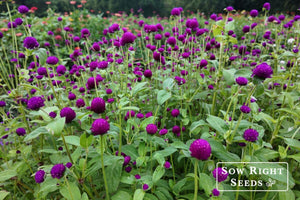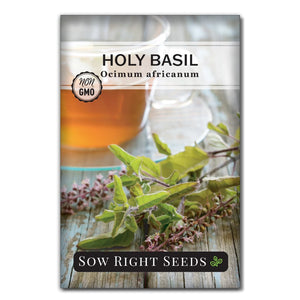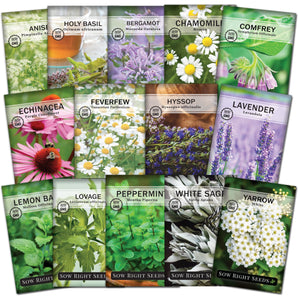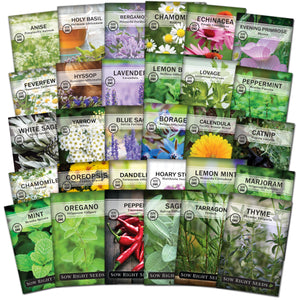Chicory Root: The Herb for Healthy Roasting and Brewing
Medicinal herbsChicory is a beautiful plant in the dandelion family with vibrant blue flowers and a rugged nature that makes it easy to grow almost anywhere. It’s a delightful addition to any garden where it will attract pollinators and help improve soil conditions.

Although there are many varieties of chicory, including leafy forms like radicchio and endive, root chicory has been grown for thousands of years as both a medicinal and culinary herb. Let’s look at how to grow, harvest, and use chicory for yourself.

Growing Chicory from Seed
Chicory thrives in poor soil, but needs good drainage. While it's adaptable to different conditions, a sunny spot will encourage better growth and flowering.
- Sow chicory seeds directly outside as soon as the thawed soil can be worked in spring.
- Space the seeds about 6-8 inches apart and cover lightly with soil.
- Water thoroughly and keep evenly moist until the seedlings are well established.

Growing and Caring for Chicory Root
Chicory root can be grown as an annual or perennial. The roots tend to get more bitter over time, so many gardeners harvest all the roots after two years.
Once the chicory plants bloom, they will produce seeds. Plan accordingly if you don't want it reseeding.
Sun
Chicory starts out with green leaves and needs sunshine for good growth and flowering.
Soil
Chicory can grow in all types of soil. Its long taproot helps it survive even in hard and rocky soils. However, it needs good drainage to prevent root rot. Plant chicory in loose, loamy soil if you are growing it for the purpose of harvesting the roots.
Water
Chicory is relatively drought-tolerant after the initial growth phase, so as the plants mature, gradually reduce watering. A lack of water will encourage it to go to seed.

How to Harvest Chicory Root
Chicory leaves can be picked throughout the growing season to use as a green leafy vegetable. They are less bitter when they're young and tender, so start harvesting early.
Chicory roots are typically ready for harvest after the plant has been growing for about 4-6 months. Fall is the ideal time, as the cooler temperatures lend the roots a sweeter taste. Dig around the plant to loosen the soil and gently extract the root.
The Benefits of Chicory Root
Chicory’s Benefits for the Garden
In the garden, chicory’s deep taproot can break up compacted soils and draw nutrients from deeper layers to enrich the topsoil. The bright blue flowers attract a range of pollinators and beneficial insects that can help with garden fertility and as a natural way to help control pest populations.
Chicory as a Medicinal Herb
Chicory has a long history in herbal medicine. Chicory, especially its root, is rich in inulin, a type of prebiotic fiber that supports the growth of beneficial bacteria in the intestines. This can aid in digestion and promote a healthy gut microbiome.
Chicory is also traditionally used as a liver tonic. Chicory has natural anti-inflammatory properties and can promote urine production, which can help in flushing out toxins from the body. Recent scientific studies support this use and point to the specific compounds in chicory that may protect the liver.
Culinary Uses of Chicory
Perhaps the most well-known culinary use of chicory root is roasted and ground as a substitute or addition to coffee. This unique form of coffee offers a distinct taste and has the added advantage of being caffeine-free.
Chicory can be enjoyed as both a root and a leaf vegetable. Its versatility allows for a range of preparations, from boiling and roasting to using it raw in salads. Young, tender chicory leaves are edible and can be incorporated raw into salads. Older leaves can be blanched to reduce bitterness and improve texture.

How to Use Chicory Root
Medicinal Use
For digestive and liver support, steep dried chicory root in boiling water for 10 minutes, strain, and drink. Chicory root can also be paired with dandelion and milk thistle as a targeted liver tonic. A chicory tincture can also be created by immersing the root in high-proof alcohol for several weeks to extract the active compounds.
Chicory Coffee
To make a chicory coffee substitute, roast chicory roots at 350°F until they turn dark brown (about 30 minutes). Once roasted, grind them like you would coffee beans. Use a tablespoon for every cup of water in a coffee maker or French press, and brew as you would with regular coffee.
Chicory as a Vegetable
Fresh chicory roots can be roasted in an oven as you would any root vegetable. You can also sauté thinly sliced chicory root or leaves in olive oil with garlic and seasonings until tender. And, of course, raw young chicory leaves and root slices can be added to salads for a crisp, bitter contrast.

Chicory Blue Blossoms & Bitter Brews
This humble flower has earned its keep for centuries with its various culinary and medicinal uses. It’s also especially good at improving compacted, poor soils. It adds beauty and color while attracting bees, butterflies, and other friendly insects to the garden. Chicory is a friendly and easy-to-grow plant that deserves a place in anyone’s home garden.
If you found this information helpful, share it with a gardening friend!









Leave a comment